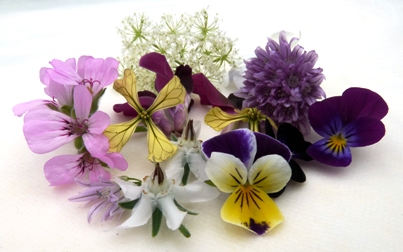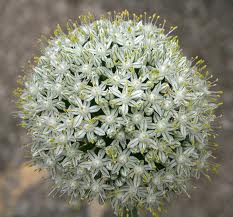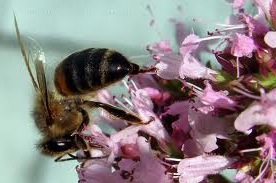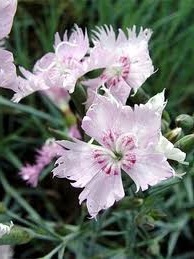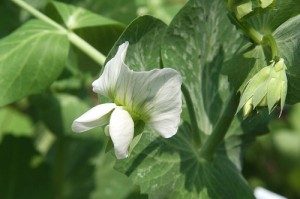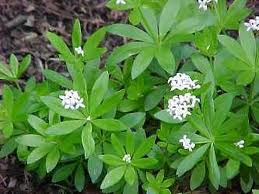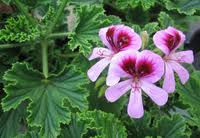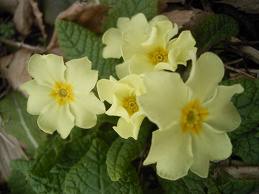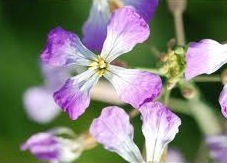Alliums, Oregano, Pinks, Peas, Okra, Galium, Ginger, Scented Geraniums, Primrose, Mustard/Radish
The author of “Florida’s Incredible Wild Edibles” Dick Deuerling, now in his 90s, taught me decades ago: If it looks like a garlic and smells like a garlic it is a garlic and you can eat it. If it looks like an onion and smells like an onion you can eat it. They must have both, however, look and aroma. We have a lily here in Florida, for example, that looks like an onion but no aroma, and raw it can be deadly. Look and aroma, like horse and carriage and love and marriage. Together. Alliums can also be deceptive. Locally the “wild onions” (read really garlics) grow their cloves on the top of the plant, not underground. And if I remember correctly, an onion always has a singular bulb per plant where as the garlic has sectioned cloves. At any rate there are some 400 species if you include onions, garlic, chives, sallots, and closely related ramps/leeks, the latter having wide leaves. Usually the flowers have a stronger flavor than the leafy parts, and the developing seed head even stronger flavor. Blossoms are usually white but can also be pink. Onion stems are round, as are chives but smaller. Garlic leaves are flat. And since you know what those look like I’ll put up a picture of ramps, unfamiliar to some.
Where would Greeks be without oregano, or the rest of us? And is it a wild plant or cultivated? In most of the New World it is a cultivated plant. In the land of my ancestors it grows wild, particularly on the lopes of Mt. Taygetos (said tah-EE-gah-tos) south of Sparta in The Mani (and from where we get the word “maniacs” in English because of how the Maniotes fought.) Taygetos means “joy of mountain.” Oregano is similar. It’s from two Greek words, oros, which means mountain, and ganousthal meaning delight in. “Delight in the mountain is” translates into good eats and where the oregano prefers to grow. There should be some truth to that because oregano also grows in Sanmaria Gorage on mountainous Crete, where I love to hike. We are told Aphrodite, the goddess of beauty, created oregano as a symbol of happiness. Ancient Greeks would crown newlyweds with garlands of oregano to bless happiness on their marriage. Oregano’s blossoms are a milder version of the plant’s leaves Incidentally, marjoram is in the same genus as oregano. Oregano is Origanum vulgare, and marjoram is Origanum majorana. Think of marjoram as oregano lite and used the same way. In many place in the Mediterranean area oregano is called Wild Marjoram.
Carnations (Dianthus caryophyllus) were covered earlier in this series but let’s revisit the genus Dianthus’ miniature versions such as Pinks and Sweet William, respectfully Dianthus plumarius and Dianthus barbatus. Dianthus means God Flower… Hmmm… would diandros be godfather? Anyway… These little carnations don’t like heat or alkaline soil which made them perfect for the cold acidic landscape of Maine’s summer. They don’t even like to be mulched. Curiously the name “Pink” does not refer to the color but a 14th century verb “to pink” meaning to perforate or create a punched patten. Apparently I grew up in the Dark Ages because it was a verb I heard around the home and every seemstress had pinking shears. Why Sweet William is called that is anyone’s guess but the term for the flower first showed up in 1596. (There were no King Williams at the time but William Shakespeare was mid-career… it’s a guess.) To use the blossoms cut away the bitter white base. The petals are sweet with a clove or nutmeg like scent. Often used in salads, aspic and soups.
There is a progression, I think. When you are a kid you hate to eat your peas. You get past that then run into your first pea pod, usually at a Chinese restaurant. You get past that when you eat your first pea blossom. Note, eating pea blossoms will reduce your production of peas but a pea blossom here or there is pleasant. They are crunchy, slightly sweet, and taste like peas. That does vary some with what variety you have planted. Also the pea shoots and tendrils are edible as well. All usually consumed raw though you could cook them. A word of caution. I am referring to edible peas, the genus Pisum, not ornamental peas. Those can be toxic.
While we’re raiding the garden let’s not forget about okra blossoms. Like many edible flowers already mentioned it is in the hibiscus clan. I have grown okra in my garden and there are dozens of cultivars to choose from that produce some variety of blossom colors. Like most hibiscus blossoms they are shy on taste but add color and texture to salads as well as an attractive garnish. Of course you could also let them go on to produce okra which is a kitchen vegetable of many uses. In fact, growing okra is for the blossoms is perhaps the quickest and easiest way to get lovely large blossoms to your table quickly. And there are “dwarf” version for patio pot use. One word of warning, some okra plants have spines… big spines.
Several Galiums grow here in Florida, one of which can be used for dye, Galium tinctorium, and one of which is edible, Galium aparine. It’s easy to sort out the two. If you can find whorls of five leaves or less it is the G. tinctorum. If you can find whorls of seven leaves or more, its the G. aparine, among other characteristic. Their blossoms are really too tiny to attend to but edible. The favored Galium, however, does not grow here but I have run into it elsewhere, Galium odoratum. Imported from Eurasia and now naturalized it grows roughly in the northeast quadrant of North America and is commonly called Sweet Woodruff, or Wild Baby’s Breath. It’s been used a lot in Europe as a flavoring particularly in German May wine. Its flavor is sweet and vanilla-like which brings us to a warning. One of the chemicals that gives it a sweet smell is coumarin. Taken in large quantities it reduces the blood’s ability to clot. Flavoring and a few blossom here or there is not a worry unless you are in frail health and already taking blood thinners.
Right outside my kitchen window grows ginger, the kind we get ginger root from and use in cooking, Zingiber officinale. I planted it several years ago and when I need ginger for cooking, I did up a piece. The word ginger comes from French gingembre which was borrowed from Medieval Latin ginginer which was bastardized from the Greek: zingiberis (ζιγγίβερις). Going back further it comes from the Indian subcontinent word inji ver. We just call it good, and a home remedy for motion sickness. Ginger blossoms are gingery and fragrant. They can be eaten raw.
Because of an early botanical screw up — among the first of many — the Geranium group can be confusing. Initially all Geraniums were in one group. But by the late 1700s it was decided they were in two different genus but both were called commonly Geraniums. Got it? Folks have been trying to keep it straight ever since. Generally speaking they fall into two groups, bitter Geraniums usually not consumed, though some can be, and scented geraniums, whose flowers we can use. The latter genus is Pelargonium. The name comes from the Greek word πελαργός, pelargós, which means stork because part of the flower looks like a stork’s beak. Scented geraniums have different scents, among them almond, apple, coconut, lemon, nutmeg, old spice, peppermint, rose, and strawberry. The flowers tend to agree with the plant’s name. They are used in salads, desserts, and drinks.
The Primrose suffered the fate of several plants. Petty, edible and showed up very early in the spring after folks had spent a long winter with no fresh food. This wasn’t an issue when there were more primroses than humans. The primrose as been so harvested in the wild that it is illegal in many of its native places in Europe to pick it. However, it is also a common garden flower and a commerial product so getting some primrose legally really isn’t an issue. In the genus Primula the Primula vulgaris blossom reminds me very much of a small magnolia blossom. Several colors are available now. Also know as Cow Slip the blossoms are bland in flavor but sweet. They can be added to salad, the bud pickled, or cooked as a vegetable. They have even been used to make wine.
Perhaps I have been remiss in these last 99 blossoms to not mention mustards more. But they are a huge family and have been touched upon, such as with arugula. They all have yellow to white blossoms, sometimes pink, usually a simple cross which is there the family names Cruciferae comes from. They range from the mustard that produces the seed that makes the condiment to the radish in our salad to the plant that produces what eventually is cleaned and deodorized into Canola oil. In northern climates they are a spring and summer plant, here in Florida they are wintertime fare, showing up after Thanksgiving and usually totally gone by St. Patrick’s day. Wild radish and wild mustard look similar but have small differences. One is that mustards grow tall, radishes like to serpentine. Radish blossoms cluster and have noticeable veins, mustard blossoms are singular and the veins are not obvious. The seeds pods are different as well. Mustard’s pod is smooth, the radish jointed and why the mustard is called the charlock and the radish the jointed charlock. Their blossoms are both peppery and mustardy. They work best in cold salads or hot soups, the latter they can be tossed in just before serving. And of course mustard and radish leaves can be cooked up as greens.

